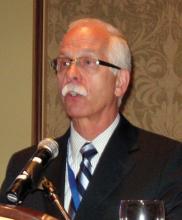LAS VEGAS – The results from the National Lung Screening Trial constitute a "game changer" for lung cancer screening, Dr. James R. Jett said at the annual meeting of the National Association for Medical Direction of Respiratory Care.
The study results, reported in a press release by the National Cancer Institute last November, "changed the landscape" for screening by showing that lung imaging by low-dose helical CT done annually for 3 years in people with a smoking history of least 30 pack-years cut their mortality rate from lung cancer during follow-up by 20%, compared with people who underwent three annual chest x-rays. "This is the biggest advance in lung cancer in my career, an absolutely stunning result," said Dr. Jett, a pulmonologist and lung cancer specialist at National Jewish Health in Denver.
The researchers who ran the National Lung Screening Trial will likely publish their full results this spring, after which annual screening of people who match the profile of those in the study should become the standard of care, Dr. Jett predicted.
The screening trial enrolled 53,454 current or former cigarette smokers aged 55-74 years, who had each accumulated at least 30 pack-years of smoking history but had quit within the previous 15 years. The more than 75,000 total screening events by CT and more than 73,000 total screens by chest x-ray yielded 24% positive CT images and 7% positive x-ray images. During roughly 144,000 person-years of follow-up in each arm, the mortality due to lung cancer reached 246 deaths per 100,000 person-years in the CT group and 308 deaths per 100,000 person-years in the x-ray group, a 20% absolute mortality reduction with CT screening that was statistically significant, and which led the trial’s Data and Safety Monitoring Board to stop the study and release the results.
The people screened by CT also had a 7% reduction in all-cause mortality, compared with those screened by x-ray, also a statistically significant difference.
As about 160,000 Americans die from lung cancer annually, a 20% cut in mortality from low-dose helical CT screening could potentially save about 32,000 lives a year in the United States alone. "That’s almost like eliminating all 40,000 breast cancer deaths each year," Dr. Jett said.
The results did not directly address the question of how long annual screening should continue. In the trial, screening stopped after three annual examinations because of limited financial resources, although despite that the study cost about $200 million, he said. But his review of the results identified no suggestion that in routine practice screening should stop after 3 years. "There was no drop in the number of cancers" during each sequential year of screening. "I don’t see anything that tells me you can stop [screening] after 3 years," he said.
"The biggest question is, can we afford" to do annual CT screening on the scale needed to include all people who fit the profile included in the trial.
A second issue is the safety of annual CT imaging, but Dr. Jett presented a brief analysis suggesting that it is safe. A low-dose CT scan involves a radiation exposure of about 0.65 mSv, less than 10% of the dose of a conventional chest CT, Dr. Jett said. With that level of exposure, annual low-dose CT imaging of currently smoking women aged 50 might cause an excess of 5 cancer deaths for every 10,000 people screened, compared with a background lung cancer mortality of 100 for every 10,000 people with no screening. Because screening could prevent 20% of these 100 deaths, it would avert more deaths that it might cause. For men, the risk: benefit ratio runs even higher because currently smoking men undergoing annual CT screening would have about 2 extra lung cancer deaths per 10,000 people due to the radiation exposure, compared with 110 per 10,000 without screening. Women face a higher risk from the radiation of screening than men because of the impact of chest radiation on breast cancer, Dr. Jett said.
Dr. Jett said that he has been an adviser to Genentech, Pfizer, and Bristol-Myers Squibb, and that he has a research grant pending from Oncimmune.


